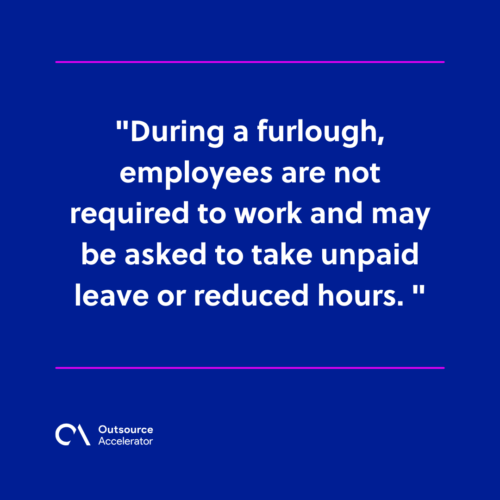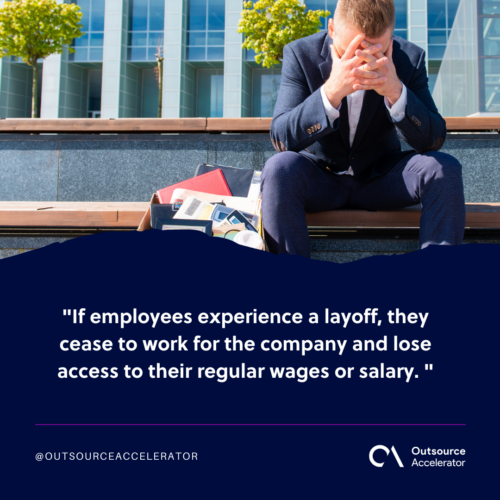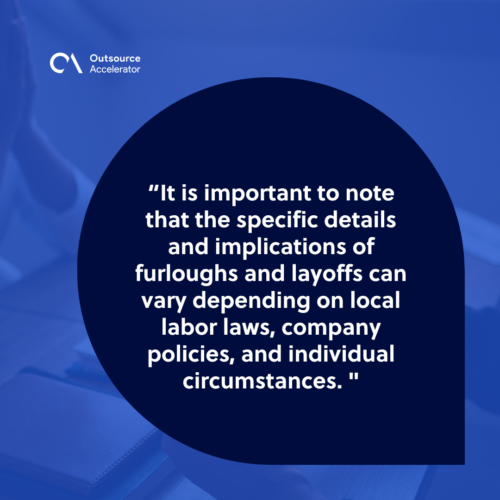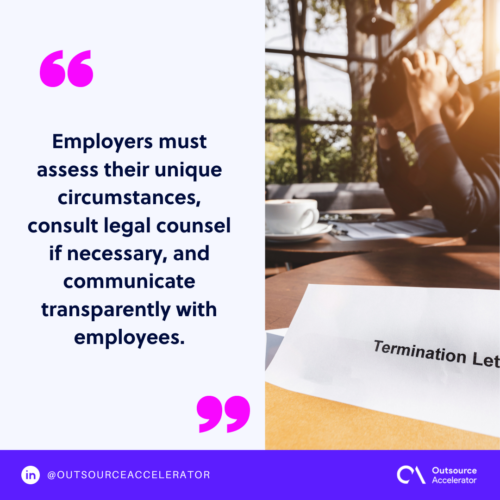Furlough vs. Layoff: What’s the difference?

Companies may implement different measures to manage their workforce in times of economic uncertainty or organizational restructuring. These include furloughs and layoffs.
While frequently used interchangeably, these two terms actually represent distinct strategies and implications to salaried employees.
But what is the difference between a furlough and a layoff?
This article examines the differences in their purposes, legal considerations, and potential impact on employees and organizations.
Furlough vs. Layoff: Definition of terms
Here’s a brief discussion of furlough vs. layoff:
What is furlough?
A furlough is an employee-granted brief leave of absence. It is usually given during a period of reduced business activity or financial hardships.
During a furlough, employees are not required to work and may be asked to take unpaid leave or reduced hours. However, they officially remain on the company’s employment log and are still entitled to certain benefits like health insurance. A furloughed worker may still be designated as a salaried employee.

The intention behind a furlough is to minimize costs while retaining skilled employees. This provides a temporary solution until normal business operations can resume.
Furloughs are often used in response to economic downturns, seasonal fluctuations, or unseen disruptions like natural disasters or pandemics.
Furloughed employees are expected to return to work when the situation improves or as agreed upon by both parties.
What is a layoff?
A layoff, meanwhile, refers to the permanent termination of employment. Unlike furloughs, layoffs are often initiated in response to more profound and lasting organizational changes.
One example is replacing a human workforce with AI alternatives. Many of the incidents that cause furloughs can also cause layoffs, such as:
- Economic downturns
- Organizational restructuring
- Technological changes
- Decline in business activity
These are typically reasons beyond the worker’s actual performance on the job. A layoff is mainly done as a measure to reduce costs and adjust workforce size.
If employees experience a layoff, they cease to work for the company and lose access to their regular wages or salary. Employers may offer severance packages to provide financial support during the transition period.
Affected individuals may also collect unemployment insurance.
Layoffs are a significant decision for both employers and staff, as they have lasting effects on the workforce and the affected employees.
Exempt employees are usually spared from layoffs due to the nature of their position.

Furlough vs. Layoff: Key differences
Furloughs and layoffs have distinct differences in terms of their nature and implications. Here are the key differences between a furlough and a layoff:
Nature and duration
Furloughs are intended to be temporary and are often implemented as a cost-saving measure. Furloughed employees are expected to return to normal work when the situation improves.
Layoffs, on the other hand, are usually permanent, though a temporary layoff is not unheard of. They indicate a more enduring change within the organization.
Employment status
During a furlough, employees remain on the company’s roster and maintain their employment status. They are, however, temporarily relieved of their duties and typically do not receive regular wages like before.
In a layoff, employees are permanently severed from the employer-employee relationship. They no longer hold a position within the company and are free to conduct a job search.
Compensation and benefits
While on furlough, employees may experience a reduction in work hours or unpaid leave, resulting in reduced or no pay. Some benefits may still be accessed, though there may be adjustments.
These workers are still typically subject to the Fair Labor Standards Act.
Laid-off employees generally lose access to both regular wages and most employee benefits. Some employers may offer severance pay packages or unemployment benefits as a form of financial assistance.
Intent and reversibility
Furloughs are often used as a cost-saving measure during challenging times with the expectation that employees will return to work when economic conditions improve. They are designed to be reversible.
Layoffs signify a more permanent decision by the employer. While some laid-off employees may be rehired in the future, the separation is typically considered final, and workers must seek employment elsewhere.
Communication and transparency
Employers often communicate openly about the temporary nature of furloughs, detailing the reasons and expected duration.
There is an expectation of ongoing communication regarding any changes to the furlough status and when they expect to recall employees.
Layoffs may be communicated with a focus on the reasons behind the decision, but they often involve a more definitive and final break in the employment relationship.
It is important to note that the specific details and implications of furloughs and layoffs can vary depending on local labor laws, company policies, and individual circumstances.
Consulting with legal and human resources professionals is recommended for accurate and up-to-date information. It’s also a good practice to communicate the nature of the furloughs and layoffs to remaining employees.

When to furlough or lay off employees
Deciding between a furlough vs. layoff is critical and can be influenced by various factors. The choice between these two options largely depends on the nature of the challenges the business is facing and its long-term goals.
Here are some general guidelines for when to furlough or lay off employees:
Financial situation and business needs
Choose to implement a furlough period when you can foresee your temporary hardships.
Furloughs are preferable if you have the financial capacity to weather that storm. This allows you to manage costs without losing your skilled employees.
Consider a layoff if you’re undergoing significant restructuring, downsizing, or a long-term decline in business. Also, layoffs may be necessary if financial constraints are severe and likely to persist.
Legal requirements
When government support or subsidy programs are available for retaining employees during challenging times, furloughs can be a viable option. Employers must make sure to adhere to any requirements set.
If legal or regulatory considerations make permanent separations more practical, layoffs may be the preferred choice. Employers must comply with requirements like notification periods and compliance with labor laws.
Employee skill sets and flexibility
If employees possess specialized skills or are critical to long-term organizational goals, a company furlough allows for talent retention and a quick return to full operational capacity.
In cases where skillsets are not aligned with future needs or the workforce requires significant restructuring, layoffs may be more appropriate.
Employers must assess their unique circumstances, consult legal counsel if necessary, and communicate transparently with employees.

Whether furloughing or laying off, it’s not a decision to take lightly. Remember to respect your employees’ rights during this time.
Throughout the entire process of terminating employees, take special care to maintain trust and manage the impact on both the workforce and the organization.







 Independent
Independent




